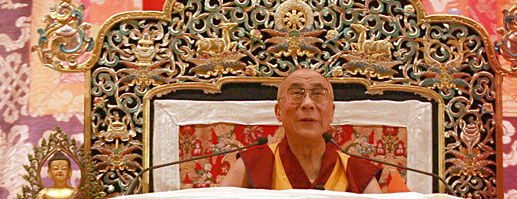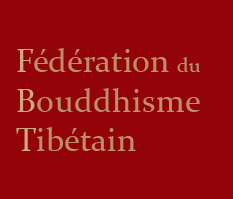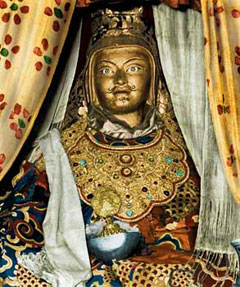

A short explanation of the teachings
His Holiness the Dalai Lama gave teachings on several texts by the great Indian master, Nagarjuna:
The Root Stanzas of the Middle Way
(skt. Mulamadhyamaka-karika, tib. dbu ma rtsa ba'i shes rab), Chapter 26 (An examination of the twelve factors of interdependent arising), chapter 18 (An examination of the self of the person and the self of phenomena) and chapter 24 (An examination of the Four Noble Truths).
The Commentary on Bodhichitta
(skt. Bodhichittavivarana, tib. Byang chub sems 'grel).
The Jewelled Necklace
(skt. Ratnavali),
Chapter 3 (A brief exposition on the causes of enlightenment).
As an introduction to these texts, the following remarks were taken from an interview with Jigmé Khyentsé Rinpotche:
These three texts are based on the Buddha’s teaching, the principal aim of which is to be a source of help for living beings. In order to understand the Buddha’s teaching, it is first necessary to realise that beings suffer. If they were not suffering, they would obviously not be in need of help. The message of the Buddha is that it is possible for all beings to bring their sufferings to an end. But in order for this to happen, they need to identify and free themselves from the cause of suffering. What therefore is this cause? We know very well that beings fall victim to their negative emotions such as anger, irritation, attachment, and all kinds of obsession. All this is founded on ignorance. It is ignorance that makes these afflictive states possible. Now in order to remove the kind of ignorance that is the origin of suffering, the Buddha gave a great number of teachings, most especially the teachings on Wisdom—which may be defined as the antithesis of ignorance, the state of “not knowing”
A particular feature of the Mahayana, the Buddhism of the Great Vehicle, is the teaching on emptiness. This teaching is expressed in a collection of scriptures known as The Perfection of Wisdom sutras—which are of various lengths. There is one in 100 000 stanzas, another in 20 000 stanzas, another in 8000 stanzas. Finally there is the famous Heart Sutra, which condenses the whole body of these teachings into a few lines.
These texts are difficult for ordinary people like ourselves. Even if we had a great deal of time and interest, it would be practically impossible for us to sound their depths. It was for this reason that Nagarjuna, a Bodhisattva of great wisdom, who received and understood these teachings, expounded them in a series of treatises, the most important of which is the Mulamadhyamaka-karika.
As we can see, the twenty-sixth chapter of this text, which His Holiness will explain, deals with the twelve factors of interdependent arising, whereby beings are bound inescapably in the cycle of existence. These factors are:
1) Ignorance, which gives rise to 2) conditioning factors. Conditioning factors give rise to 3) consciousness, which in turn results in 4) name and form. Name and form (i.e. the five aggregates) are the origin of 5) the six senses, which in turn make possible 6) contact. Because of contact there arises 7) feeling. Feeling gives way to 8) craving, which in turn produces 9) grasping. It is grasping that propels us into 10) becoming, thence to 11) birth and onward into the sequence of 12) aging and death.
We can see, once again, that the first of these twelve factors is ignorance. And it is in order to remove ignorance that Nagarjuna goes deeper and deeper in his explanation of ignorance—the ignorance of grasping or attachment, beginning with ego-clinging, which makes us think that we are more important than others. Nagarjuna’s exposition becomes increasingly subtle, exploring the condition of ego-attachment and the ignorance that is its basis, the ground from which all grasping comes. All this constitutes the analysis of the “personal self” and the “phenomenal self”.
Nagarjuna also explains the Four Noble Truths, the first of which is the Truth of Suffering. This was the very first teaching that the Buddha gave, for as we have just seen, the prime reason for which the Buddha taught at all was the fact that beings are caught and imprisoned in suffering. In order to be free from suffering, it is first necessary to identify its origin, the Truth of the Cause of Suffering. The practice that removes the cause of suffering is the Truth of the Path and this results in the Truth of the Cessation of Suffering. In order to follow this path that leads away from suffering, it is very important to have Bodhichitta, sometimes called the Mind or Attitude of Enlightenment. One could even say that without Bodhichitta it is impossible to find and follow the path and to have the ability to liberate oneself and others from sorrow.
This is the reason why texts like the Commentary on Bodhichitta were composed. Bodhichitta, the mind of enlightenment, is defined as the wish to attain complete Enlightenment for oneself and all beings. One cultivates and then trains oneself in Bodhichitta, first by generating what is called Bodhichitta in Intention, which consists basically of four things: love, compassion, sympathetic joy and equanimity. Then one must engage in Bodhichitta in Action, which consists of the six transcendent perfections: generosity, patience, discipline, diligence, concentration and wisdom. Basically, all these practices come down simply to having a good heart— benevolence and kindness—and to learning how to develop these and reap their benefits.
Regarding the Jewelled Necklace, His Holiness gave teachings on the chapter dealing with the causes of Enlightenment, and here, one of the main causes is, once again, Bodhichitta, the Mind of Enlightenment.
Considering such a programme of teachings, it is easy to see that everything it contained was of the greatest benefit to us all. And once again—because Nagarjuna’s writings are often very difficult to understand fully—His Holiness explained these teachings in words that everyone found quite easy to understand.
So this was an ideal occasion for everyone—whether we were already engaged on the spiritual path or whether we were still searching for it. This was a very fortunate meeting of circumstances. On the one hand, there were people interested in Buddhist teachings and who wanted to know more about them. On the other hand, there was His Holiness, who had studied these teachings deeply for many years and had a profound understanding and perfect mastery of them. His Holiness was present and all who heard about the event or read about it on the internet was able to come to Nantes to meet him. What better opportunity could there possibly have been ?
Padmasambhaba Empowerment
In the morning of Wednesday 20 August 2008, His Holiness bestowed an empowerment of Padmasambhava taken from the “Innermost Embodiment of Accomplishment”, according to the secret teachings of the Fifth Dalai Lama.
Padmasambhava
From the outer, historical, point of view, Padmasambhava (referred to reverentially as Guru Rinpoche) was a Buddhist master from the ancient country of Oddiyana—probably the Swat valley in Pakistan—who established Buddhism in Tibet in the eighth century. At the invitation of King Trisong Detsen, he assisted the Indian Abbot Shantarakshita in completing the construction of the monastery of Samye, and under their direction, a very large collection of the Buddhist texts then available in India were translated into Tibetan. Guru Rinpoche himself taught very extensively on the vajrayana, the adamantine vehicle of Secret Mantra.

Padmasambhava
From the Dharma point of view, certain sutras record that Buddha Shakyamuni himself prophesied that, following his parinirvana, he would again appear in the world in the form of Guru Rinpoche. Consequently revered as the Second Buddha, Guru Rinpoche is considered the embodiment of all enlightened beings of the past, present and future. His activity for the benefit of beings was and is inconceivable, for he created a situation in Tibet thanks to which the three vehicles of Buddhism, especially the Vajrayana, could be preserved perfect and intact until the present age.
It is thanks also to Guru Rinpoche that there exists the tradition of hidden spiritual treasures called termas.
Broadly speaking, the terma tradition can be understood as follows. When Guru Rinpoche was engaged in the task of implanting and propagating the Buddhist teachings in Tibet, he realised that a number of his instructions were more appropriate to future times when their meaning would be more accessible and applicable to the changing needs, mode of life and capacity of later generations. Being a master of unobstructed yogic power, he sealed these teachings within the deepest layers of the consciousness of his closest disciples and concealed material objects, the supports for these teachings, within the essence of the elements (in rocks, lakes and so forth). Guru Rinpoche’s closest disciples were themselves already masters of high accomplishment and in their subsequent incarnations, depending on the quality of the time and according to Guru Rinpoche’s prophetic instructions, they have been able to discover and reveal these treasures, and to transmit them to their contemporaries. It is thus that from the time of Guru Rinpoche’s visit to Tibet until our own day, an uninterrupted stream of treasure teachings has been revealed. Although the terma tradition is found in other schools of Buddhism, it is a particular feature of the Nyingma, or Ancient Translation School of Tibetan Buddhism, where it provides one of the main sources of study and meditative practice.
Gyalwa Ngawang Losang Gyatso, the fifth Dalai Lama (1617-1682), often referred to simply as “the Great Fifth” on account of his spiritual, political and cultural influence in the history of Tibet, was himself a revealer of Guru Rinpoche’s spiritual treasures. Identified in certain prophecies as the manifestation of the enlightened activity of the King Trisong Detsen himself, the fifth Dalai Lama enjoyed many profound spiritual experiences from this earliest childhood. He had numerous visions of Guru Rinpoche, in the course of which he received many teaching transmissions, one of which was the Innermost Embodiment of Accomplishment, the empowerment of which will be given by His Holiness in Nantes.
Empowerment
“Empowerment” or “initiation” are translations of the Tibetan word wang. Of these two terms, “initiation”, though in many ways unsatisfactory, reflects the fact that the wang is the indispensable point of entry into the teaching and practice of the tantras. On the other hand, “empowerment” is closer to the Tibetan word and refers to the transmission of wisdom power from master to disciples, allowing and enabling them to engage in the practice and to reap its fruits.
As a means to understanding what is meant by the transmission of power, the following remarks of the His Holiness will be helpful.
“What is the meaning of the term wang, or empowerment? To begin with, our fundamental nature—what we call the “Buddha nature”, the true nature of our minds—is present within us naturally and inherently. This mind of ours, as also its most subtle nature, is a continuum that has endured from beginningless time. It is because of the continuum of this subtle nature that we have the capacity to attain Enlightenment. This potential is called the seed of awakening, the Buddha nature, the fundamental nature, or in Sanskrit the tathagatagarbha. We all have the Buddha nature, each and every one of us. When we pay homage to images of the Buddha, we are honouring someone who awakened into the state of enlightenment, and this was possible precisely because the Buddha nature was his own true nature. It is our true nature too. And in the same way that the Buddha attained enlightenment in the past, we too can become the Buddhas of the future.
When the moment of our enlightenment arrives, the subtle continuum of our minds will awaken into a state of omniscience, called in Sanskrit the dharmakaya. The nature of the mind is called the svabhavikakaya. The fact that the mind is by its very nature totally pure is one of the aspects of this svabhavikakaya, that of total and natural purity. And the removal of defilement occurring at enlightenment corresponds to another aspect of the svabhavikakaya, that of being free of adventitious obscuration.
The Buddha-potential abides within us all. It is what makes enlightenment and the attainment of omniscience possible. Empowerment or initiation sets in motion a process whereby the nature of the mind is able to express itself more fully. When an empowerment is conferred on you, it is the nature of your mind, your Buddha nature, that acts as the basis for the ripening effects of the empowerment. It is thanks to such transmissions of power that you are initiated into the essence of the five Buddha families…”
(Taken from a teaching given at Vincennes, 7 October 1982 during the transmission of the Sangwa Gyachen, another spiritual treasure revealed by the fifth Dalai Lama.)
In this age of spiritual decadence, to receive an initiation of Guru Rinpoche is a source of great blessing. This will help to remove personal sufferings such as all kinds of frustration, sickness and so on. On the outer level too, it will help to pacify wars and conflicts, epidemics, famines and the other ills that afflict the world. To practise the treasure teachings or simply recite the mantra is considered to be a powerful way of removing obstacles so that one may progress rapidly on the spiritual path.
This initiation was open to everyone and it was possible to receive it simply as a blessing.
Those who received the empowerment and who would like to have a copy of the text of the practice should contact Padmakara at editions@padmakara.com